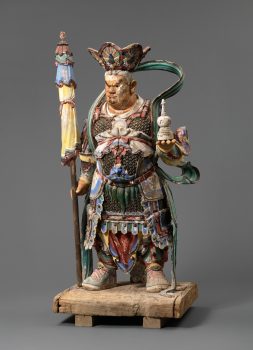China
17th - 18th century





China
17th - 18th century





This astonishingly well-preserved and colorful clay image represents the Guardian King of the West, Virupaksha. He is the king of the naga, the snake beings of the underground. In this rather unusual form the guardian king is orange and holds a victory bannerin his right hand and a stupa in his left. He wears the armor of a warrior but a large crown featuring the Five Buddhas instead of a helmet. Virupaksha’s name refers to his damaging gaze—his eyes are emphasized here with stone inlays. This lively sculpture is remarkable for its sophisticated workmanship, extensive use of color, and good state of preservation. Even the fragile scarf floating behind the head has survived. The figure is short and sturdy and has a massive head dwarfed by an even more dominant crown. The solid body and stance, expressing certainty and stability, contrast with the figure’s facial expression, his large but comparatively fragile crown, and his floating scarf, all of which convey a sense of motion. This sculpture is made from unfired clay, the most used material for sculpture in the Himalayas for centuries. In this traditional method, clay is mixed with paper and water to form a hollow sculpture. The inner form is gradually built by using coiled clay strips that are thinned by hand. Much finer clay is then used for the surface details of the sculpture. Separately molded limbs, ornaments, and head are then attached to the figure, and finally the sculpture is painted and filled with consecrated materials. Large clay statues such as this can serve as main images in temples. This one probably once stood vigilantly at the entrance gate of a temple or monastery as one of the Four Guardian Kings. Clay bricks often form the base of these statues. A wooden armature typically provides the underlying structure and X-rays show internal structural supports of wood and wire.
A kind of energy that can be used, individually and collectively, to effect change.
A meditation technique primarily used in tantric practice that involves imagining a deity in one’s mind or imagining oneself becoming a deity and carrying out various activities. Such techniques are intended to help a practitioner transform ordinary perception and achieve enlightened qualities.
Himalayan art includes portraits of legendary and historical humans, including accomplished religious teachers (lamas), the Buddha’s original disciples (arhats), and spiritually accomplished tantric masters (mahasiddhas).
Although Tibetan Buddhism was not practiced broadly in China, the imperial centers, such as Beijing and Mount Wutai, emerged as hubs of Tibetan Buddhist cultural production. The emperors of the Mongol Yuan (1271–1368), Chinese Ming (1368–1644), and Manchu Qing (1644–1911) dynasties harnessed Tibetan Buddhist ideas to consolidate their power.
Get the latest news and stories from the Rubin, plus occasional information on how to support our work.